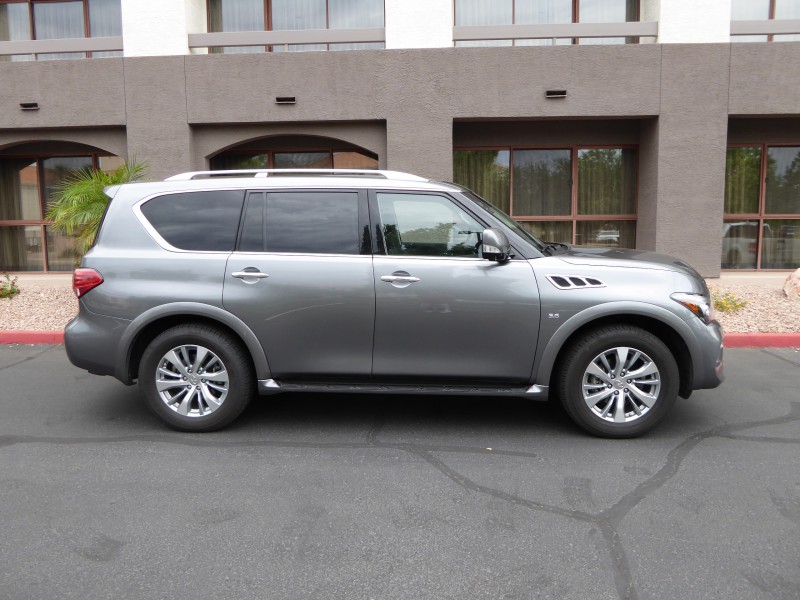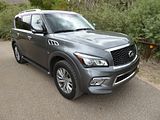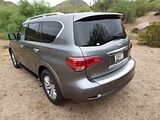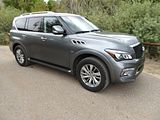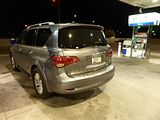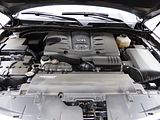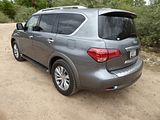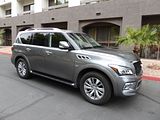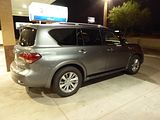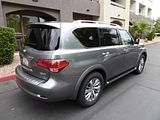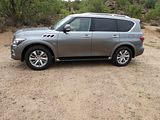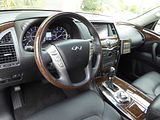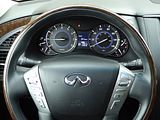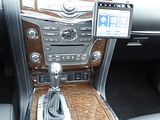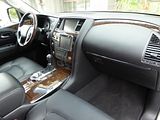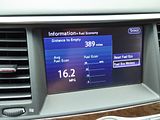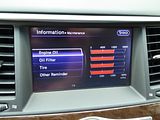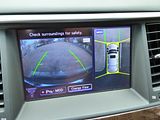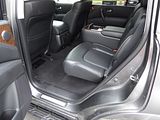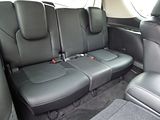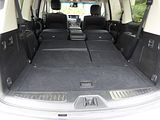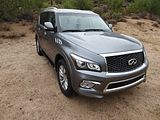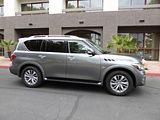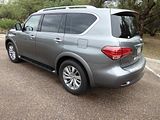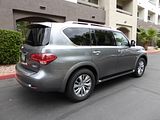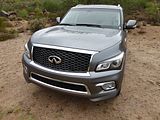
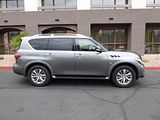
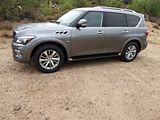
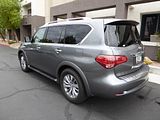

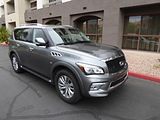
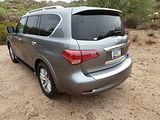
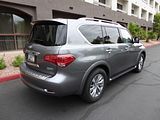
Like its predecessor, motive power for the QX80 is a 5.6 litre V8 engine. It is, however, a new unit, with direct injection and VVEL variable valve timing, also found in the Nissan Patrol. It is rated at 400 hp and produces 413 lb·ft of torque. The more powerful engine helps give the QX an increased towing capacity of up to 8,500 pounds. The engine is tied to a seven-speed sequential-shift automatic transmission with an all-new optional 4WD system. The QX80 is still built according a body-on-frame concept, but it does have front and rear double wishbone independent suspension which can be combined with an optional Hydraulic Body Motion Control System, which should make the car lean less in turns, though may compromise the ride somewhat. I do not believe it was on the test car but it did have the optional AWD set up. Getting in the QX80 and firing the engine for the first time, something you do with keyless starting, by pressing a button to the right of the wheel, and there is quite a roar as this large capacity unit awakes from its slumbers, and this sensation is emphasised when the Infiniti is in an enclosed space, such as the Sky Harbor rental car structure which is where I was when I first started the beast up. The rumble of those 8 cylinder firing quickly subsides, and remains quite muted once underway. Indeed noise levels when driving along are very low indeed. Although this is a huge vehicle, and that is something you can never forget when you are driving it, it is more athletic than you would think. Those 400 horses are sufficient to give the QX80 a lively performance. Press the throttle even quite gently and you will increase speed at a rate which is initially surprising, and despite the volume of air that has be pushed out of the way as you progress, it accelerates quite rapidly. I guess anything that can seat up to 7 and tow up to 8500 pounds is going to be quite responsive when one-up and with nothing attached behind. The transmission is very smooth, shifting between the gears almost imperceptibly. There is a manual over-ride available if you want, but I chose to leave it to work things out for itself. There is a downside, though, even if you don’t exploit much of the performance or the load-carrying ability and that is the fuel consumption. Be in no doubt that the QX80 has a prodigious thirst. I only drove the Infiniti for 106 miles and few of those were at freeway speed, but even so, I needed to put 6 gallons in to fill it up. That equates to 17.66 mpg, which is not that impressive, especially when you learn that a more likely average is probably a few mph short of that. Although I felt that this bulky machine was not intimidating to drive, nor was it much fun. Riding on standard 22″ wheels, the soft suspension made it feel rather wallowy, though it also seem to feel every ridge in the road, and this was in Arizona, where road surfaces are generally quite good., Heaven help it in California. The steering is light, and needed almost constant correction to keep the QX80 on course. Perhaps when it is more heavily laden, it comes into its own. It’s a big vehicle with a relatively high centre of gravity, so this is not the sort of machine that you throw into the bends, so, needless to say, I did not push is that hard even on gently swooping curves. There is plenty of body roll even at moderate speeds. There are four different modes for the AWD set up: Auto, High, Low and Snow. These are selected using a rotary dial that is behind the gearlever. The brakes worked well, with a nicely progressive feel to the pedal. There is a foot operated parking brake. Clearly you sit far higher in this car than you do in most, so you get a good view looking down over the traffic. There’s a good glass area, too and there are various technology aids to help you to position the QX80, with a warning for a vehicle in your blind spot on the driver’s door mirror and mirrors that tilt down when reversing, as well as the useful rear-view camera.
Getting in is not that hard, even for someone like me who is not tall and who is blessed with short legs. There is a running board to help you, and I certainly needed it both for entry and egress. Once installed, there is electrical assistance to move things around to get comfortable. The column powers in and out as well as up and down, with a wide range of adjustment on offer. And the power-operated seats move back and forth, up and down and with adjustable backrest rake and lumbar support to ensure that you can get the driving position that you want. I did not spend any prolonged time behind the wheel, but from the time I was there, the leather trimmed seat certainly seemed a bit flat, so I am unsure whether it would prove supportive enough were you to sit on for lengthy periods. There are 2 memory settings available so you can store your favoured position. The seat powers back when you open the door, giving you more space between it and the steering wheel, and it then motors back to the chosen setting.
You probably would not need any marque badging to tell that you were in an Infiniti, as several of the design features that you see in other models in the range are present here, too. Everything is leather wrapped, with relatively discrete stitching and there are large areas of highly polished wood trim, including the outer part of the steering wheel rim which all try to endow the car with an up-market feel. I would say that it is a good effort, but does not quite hit the spot, though it does not feel as tawdry looking as some brands manage. Everything is neatly presented and easy to use, although by the standards of 2015/6, it is perhaps a little old-fashioned looking. The instruments are grouped together under a single curved cowl. There are two large ones, for speedometer and rev counter, and four smaller ones for fuel level, water temperature, oil pressure and an ammeter, which are outside the larger dials. All are neatly marked and easy to read. In the middle of the display is an area for the odometer and trip computer data. The centre of the dash has a recessed 8″ colour display screen for the infotainment system, set between a pair of air vents, which looks like the unit you get in lesser Infinitis. The graphics on this are clear and crisp. As well as being used for the standard navigation system, and the rear-view camera, it shows details on audio selections, maintenance and vehicle information and trend data such as fuel consumption averages. You cycle through the various functions using the series of buttons in a unit below which controls the navigation system, and other display features. Below this are the controls and settings for the audio system and below this another set for the climate control. Although this is quite a lot of buttons and knobs, the set up in neat and logical, so it is not hard to use. At the very bottom of the central part of the dash are a further row of switches which do things like seat heating and disabling the passenger air bag. There are a lot of very small and slightly fiddly buttons on the steering wheel spokes for audio unit repeater functions and cruise control. There are twin column stalks for indicators and wipers, and the lights operate from a turn sleeve on the end of the indicator stalk.
The reason that people buy a behemoth of this size is for the space inside it, most probably for people. There are three rows of seats. Those in the middle row get a good deal. That will only be two people, though, as between the two large seats is a huge divider which functions as an armrest and has a cubby with cup-holders in its front portion. This unit is fixed, so remains in place, polished wood front and all, even when the seats alongside it are folded down. Space is generous in all directions, with plenty of leg and head room, and as the seats are wide, even the widest of rear seat occupants would not want for shoulder room. You can specify a bench seat instead. Things are not quite so spacious for those in the third row. Like most vehicles, even of this size, these are better suited for children than adults, certainly if you want to put three people in here. The backrests are not that long, and to be comfortable you will need to pull the pair of headrests up to provide further support. Getting in is a bit awkward, as it is on almost all 7-seaters. Leg room is reasonable, but because there is no well for your feet, you will likely find that “knees near your chin” feeling. When all seats are in use, the available luggage space is not that large, as it is fairly short from front to back, though it is actually better than some of its competitors, all of which have the same issue. More space can be created by dropping the rear seats, which is done electrically, by pressing switches on the side panels of the boot. The rearmost seats are split asymmetrically. Once folded, the load area is completely flat. The same is true when the second row are folded down, and once this is done, there is a vast and flat area for lots and lots of luggage. There is a small area out of sight under the boot floor. The tailgate is huge and heavy, but it is electrically powered, both to open and to close, so this is not really an issue. Inside the cabin there is a massive glovebox, there are bins on all four doors and there are cubbies under the central console. Rear seat passengers get map pockets on the back of the front seats.
Unlike most models these days, there are no different trim versions of the QX80, just a choice of RWD or AWD, and then a selection of items from the options list. Even without doing so, the QX80 comes well equipped, as you might expect for a vehicle sold as a luxury SUV, and listing at a whisker under $62,000, with lots of chrome trim, 22″ alloys, a glass tilt/slide sunroof, chromed roof rails, full leather trim, semi-aniline leather seats, tri-zone climate control, a Bose 2-channel, 13-speaker Premium Audio surround sound stereo system with hard drive memory storage, hard-drive based navigation system, XM satellite radio with NavTraffic, along with a power-assisted tailgate, and Infiniti Intuitive Park Assist, a parking assist feature which uses the around view monitor. Other features include climate-controlled front and rear seats, a heated steering wheel, streaming audio via Bluetooth wireless technology, a centre console, power sliding rear seats, power third row seats, and a 7-inch DVD rear-seat entertainment system. Curtain Vent, new for this generation, directs air flow from the air conditioning system from above each side window down towards the floor. A new Around View Monitor system uses a camera mounted on the grille, giving a 180-degree view in front, and another camera mounted on the passenger side of the vehicle’s side mirror helps eliminate blind spots on the side at low speeds, such as when in parking lots or on off-road adventures.
I have to admit to having mixed feelings about the QX80. It’s hard to put my finger on why, as if you look at what it sets out to do, then it follows the brief pretty well. It is spacious enough to carry lots of people, and presumably their belongings, including a hefty towed weight, in cocooned luxury. It is nicely finished, and it goes well. It is not the last word in driving finesse, something which I think Range Rover and to a slightly lesser extent Mercedes with their GL (GLS in new speak) do rather better. It is thirsty, but all vehicles of this size and weight are going to have that problem. It was even not that intimidating to drive – in the wide open spaces of Arizona, at least. So why do I not find myself liking it more? I think it is because with this generation, compared to its predecessor, it is just that bit more brash. The styling and detailing is half a step away from being truly vulgar (and plenty of after-market firms can help you get all the way there if you want, with chrome rims, black paint and blackened windows just the start of what they can do) and that is just not my style. I like cars that are that bit more subtle, rather than those that wear all their aspirations on the outside. So, perfectly worthy and a strong competitor to the Escalade and Navigator, for sure, as well as the Lexus LX570, but not really a car that I would actively go and choose again, even if that V8 rumble was quite seductive.
With sales of SUVs starting to take off in the 1990s, it was an inevitability that manufacturers would look to extend the formula in every direction they could think of. Sales volume would clearly come by offering a series of smaller models, but profit would come by making larger and more expensive examples of the genre. Lincoln proved with their Navigator that there were plenty of customers willing to pay premium pricing for something that had its origins in a truck, and Cadillac proved that this was not a one-off phenomenon in their hastily conceived Escalade, their response to Ford Motor Company’s first salvo in the battle for creating and capturing a market in high end SUV products. Not surprisingly, it was the Japanese who joined in next, with both Lexus and Infiniti producing luxury versions of their high-end truck-based machines. The Infiniti model, called the QX56, was based on the full-sized Armada SUV, which itself was based on the Titan pick-up truck. It was launched in 2004, was made in America, and sat at the top of a range of cars which did seem to combine sport and luxury quite nicely. Bold, brash, and just massive, there turned out to be quite a market for the QX56, which was sold successfully in North America and the Gulf States. It soon became Infiniti’s best-selling SUV, out-ranking the smaller EX and FX models. Even so, sales volumes were not so great that the model could survive on its own. As it was closely related to the Armada and the Titan, it was clear that when they were to be replaced, then something would have be done with the Infiniti as well. Slightly surprisingly, the decision was taken not simply to build a replacement on the same basis as the first, but that the new model, code named Z62 in Nissan speak, development of which was begun in 2006, would be separate from the Armada, and instead be based on the Nissan Patrol and the vehicle would be produced in Japan. The 2007 styling proposal by Shinya Momokawa and Akihiro Sugita was approved by the board and frozen for production. In September 2009, spy photographs of a 2011 QX56 (Z62) prototype, at a Las Vegas Infiniti national dealer conference, were published online and on March 31, 2010, Infiniti debuted the 2011 QX56 at the New York International Auto Show. The new QX56 looked not unlike its predecessor, but in fact every panel was new. No longer sharing a platform with the Nissan Armada, the QX56 is now a luxury version of the Nissan Patrol, which also marks the first time that a Patrol-based vehicle is being sold in North America. I sampled the QX80’s predecessor just as it was being replace by this model and was slightly surprised to discover that this was a full 5 years ago. When Hertz at Phoenix Airport came up with a 2015 model QX80 as a fairly hefty upgrade from what I had booked, I did not need a lot of persuading to take it, as although I’ve driven a lot of vehicles since that QX56 test, many of the conclusions from that drive also conducted in Arizona, remained in the memory, and I was keen to see how the later car had evolved. I could summarise the whole test by saying that the first impressions were that this QX80 seemed very little different from that 2010 model year QX56. That means a combination of Good and Not so Good. Read on.
Like its predecessor, motive power for the QX80 is a 5.6 litre V8 engine. It is, however, a new unit, with direct injection and VVEL variable valve timing, also found in the Nissan Patrol. It is rated at 400 hp and produces 413 lb·ft of torque. The more powerful engine helps give the QX an increased towing capacity of up to 8,500 pounds. The engine is tied to a seven-speed sequential-shift automatic transmission with an all-new optional 4WD system. The QX80 is still built according a body-on-frame concept, but it does have front and rear double wishbone independent suspension which can be combined with an optional Hydraulic Body Motion Control System, which should make the car lean less in turns, though may compromise the ride somewhat. I do not believe it was on the test car but it did have the optional AWD set up. Getting in the QX80 and firing the engine for the first time, something you do with keyless starting, by pressing a button to the right of the wheel, and there is quite a roar as this large capacity unit awakes from its slumbers, and this sensation is emphasised when the Infiniti is in an enclosed space, such as the Sky Harbor rental car structure which is where I was when I first started the beast up. The rumble of those 8 cylinder firing quickly subsides, and remains quite muted once underway. Indeed noise levels when driving along are very low indeed. Although this is a huge vehicle, and that is something you can never forget when you are driving it, it is more athletic than you would think. Those 400 horses are sufficient to give the QX80 a lively performance. Press the throttle even quite gently and you will increase speed at a rate which is initially surprising, and despite the volume of air that has be pushed out of the way as you progress, it accelerates quite rapidly. I guess anything that can seat up to 7 and tow up to 8500 pounds is going to be quite responsive when one-up and with nothing attached behind. The transmission is very smooth, shifting between the gears almost imperceptibly. There is a manual over-ride available if you want, but I chose to leave it to work things out for itself. There is a downside, though, even if you don’t exploit much of the performance or the load-carrying ability and that is the fuel consumption. Be in no doubt that the QX80 has a prodigious thirst. I only drove the Infiniti for 106 miles and few of those were at freeway speed, but even so, I needed to put 6 gallons in to fill it up. That equates to 17.66 mpg, which is not that impressive, especially when you learn that a more likely average is probably a few mph short of that. Although I felt that this bulky machine was not intimidating to drive, nor was it much fun. Riding on standard 22″ wheels, the soft suspension made it feel rather wallowy, though it also seem to feel every ridge in the road, and this was in Arizona, where road surfaces are generally quite good., Heaven help it in California. The steering is light, and needed almost constant correction to keep the QX80 on course. Perhaps when it is more heavily laden, it comes into its own. It’s a big vehicle with a relatively high centre of gravity, so this is not the sort of machine that you throw into the bends, so, needless to say, I did not push is that hard even on gently swooping curves. There is plenty of body roll even at moderate speeds. There are four different modes for the AWD set up: Auto, High, Low and Snow. These are selected using a rotary dial that is behind the gearlever. The brakes worked well, with a nicely progressive feel to the pedal. There is a foot operated parking brake. Clearly you sit far higher in this car than you do in most, so you get a good view looking down over the traffic. There’s a good glass area, too and there are various technology aids to help you to position the QX80, with a warning for a vehicle in your blind spot on the driver’s door mirror and mirrors that tilt down when reversing, as well as the useful rear-view camera.
Getting in is not that hard, even for someone like me who is not tall and who is blessed with short legs. There is a running board to help you, and I certainly needed it both for entry and egress. Once installed, there is electrical assistance to move things around to get comfortable. The column powers in and out as well as up and down, with a wide range of adjustment on offer. And the power-operated seats move back and forth, up and down and with adjustable backrest rake and lumbar support to ensure that you can get the driving position that you want. I did not spend any prolonged time behind the wheel, but from the time I was there, the leather trimmed seat certainly seemed a bit flat, so I am unsure whether it would prove supportive enough were you to sit on for lengthy periods. There are 2 memory settings available so you can store your favoured position. The seat powers back when you open the door, giving you more space between it and the steering wheel, and it then motors back to the chosen setting.
You probably would not need any marque badging to tell that you were in an Infiniti, as several of the design features that you see in other models in the range are present here, too. Everything is leather wrapped, with relatively discrete stitching and there are large areas of highly polished wood trim, including the outer part of the steering wheel rim which all try to endow the car with an up-market feel. I would say that it is a good effort, but does not quite hit the spot, though it does not feel as tawdry looking as some brands manage. Everything is neatly presented and easy to use, although by the standards of 2015/6, it is perhaps a little old-fashioned looking. The instruments are grouped together under a single curved cowl. There are two large ones, for speedometer and rev counter, and four smaller ones for fuel level, water temperature, oil pressure and an ammeter, which are outside the larger dials. All are neatly marked and easy to read. In the middle of the display is an area for the odometer and trip computer data. The centre of the dash has a recessed 8″ colour display screen for the infotainment system, set between a pair of air vents, which looks like the unit you get in lesser Infinitis. The graphics on this are clear and crisp. As well as being used for the standard navigation system, and the rear-view camera, it shows details on audio selections, maintenance and vehicle information and trend data such as fuel consumption averages. You cycle through the various functions using the series of buttons in a unit below which controls the navigation system, and other display features. Below this are the controls and settings for the audio system and below this another set for the climate control. Although this is quite a lot of buttons and knobs, the set up in neat and logical, so it is not hard to use. At the very bottom of the central part of the dash are a further row of switches which do things like seat heating and disabling the passenger air bag. There are a lot of very small and slightly fiddly buttons on the steering wheel spokes for audio unit repeater functions and cruise control. There are twin column stalks for indicators and wipers, and the lights operate from a turn sleeve on the end of the indicator stalk.
The reason that people buy a behemoth of this size is for the space inside it, most probably for people. There are three rows of seats. Those in the middle row get a good deal. That will only be two people, though, as between the two large seats is a huge divider which functions as an armrest and has a cubby with cup-holders in its front portion. This unit is fixed, so remains in place, polished wood front and all, even when the seats alongside it are folded down. Space is generous in all directions, with plenty of leg and head room, and as the seats are wide, even the widest of rear seat occupants would not want for shoulder room. You can specify a bench seat instead. Things are not quite so spacious for those in the third row. Like most vehicles, even of this size, these are better suited for children than adults, certainly if you want to put three people in here. The backrests are not that long, and to be comfortable you will need to pull the pair of headrests up to provide further support. Getting in is a bit awkward, as it is on almost all 7-seaters. Leg room is reasonable, but because there is no well for your feet, you will likely find that “knees near your chin” feeling. When all seats are in use, the available luggage space is not that large, as it is fairly short from front to back, though it is actually better than some of its competitors, all of which have the same issue. More space can be created by dropping the rear seats, which is done electrically, by pressing switches on the side panels of the boot. The rearmost seats are split asymmetrically. Once folded, the load area is completely flat. The same is true when the second row are folded down, and once this is done, there is a vast and flat area for lots and lots of luggage. There is a small area out of sight under the boot floor. The tailgate is huge and heavy, but it is electrically powered, both to open and to close, so this is not really an issue. Inside the cabin there is a massive glovebox, there are bins on all four doors and there are cubbies under the central console. Rear seat passengers get map pockets on the back of the front seats.
Unlike most models these days, there are no different trim versions of the QX80, just a choice of RWD or AWD, and then a selection of items from the options list. Even without doing so, the QX80 comes well equipped, as you might expect for a vehicle sold as a luxury SUV, and listing at a whisker under $62,000, with lots of chrome trim, 22″ alloys, a glass tilt/slide sunroof, chromed roof rails, full leather trim, semi-aniline leather seats, tri-zone climate control, a Bose 2-channel, 13-speaker Premium Audio surround sound stereo system with hard drive memory storage, hard-drive based navigation system, XM satellite radio with NavTraffic, along with a power-assisted tailgate, and Infiniti Intuitive Park Assist, a parking assist feature which uses the around view monitor. Other features include climate-controlled front and rear seats, a heated steering wheel, streaming audio via Bluetooth wireless technology, a centre console, power sliding rear seats, power third row seats, and a 7-inch DVD rear-seat entertainment system. Curtain Vent, new for this generation, directs air flow from the air conditioning system from above each side window down towards the floor. A new Around View Monitor system uses a camera mounted on the grille, giving a 180-degree view in front, and another camera mounted on the passenger side of the vehicle’s side mirror helps eliminate blind spots on the side at low speeds, such as when in parking lots or on off-road adventures.
I have to admit to having mixed feelings about the QX80. It’s hard to put my finger on why, as if you look at what it sets out to do, then it follows the brief pretty well. It is spacious enough to carry lots of people, and presumably their belongings, including a hefty towed weight, in cocooned luxury. It is nicely finished, and it goes well. It is not the last word in driving finesse, something which I think Range Rover and to a slightly lesser extent Mercedes with their GL (GLS in new speak) do rather better. It is thirsty, but all vehicles of this size and weight are going to have that problem. It was even not that intimidating to drive – in the wide open spaces of Arizona, at least. So why do I not find myself liking it more? I think it is because with this generation, compared to its predecessor, it is just that bit more brash. The styling and detailing is half a step away from being truly vulgar (and plenty of after-market firms can help you get all the way there if you want, with chrome rims, black paint and blackened windows just the start of what they can do) and that is just not my style. I like cars that are that bit more subtle, rather than those that wear all their aspirations on the outside. So, perfectly worthy and a strong competitor to the Escalade and Navigator, for sure, as well as the Lexus LX570, but not really a car that I would actively go and choose again, even if that V8 rumble was quite seductive.

